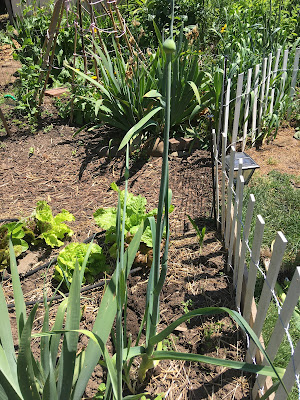The June garden is pure abundance. It's too late to plant most summer veggies now in my valley, and too early to start fall crops, so my focus is on garden care - watering, weeding, mulching - and on HARVEST.
We have kale, lettuce, parsley, rhubarb, bok choy, and soon we will also have peas, raspberries, and strawberries to harvest.
Agenda:
1. June permaculture plan
2. June planting tips
3. Squash bugs
1. June permaculture plan:
Here's my plan-
Here's my plan-
My elephant garlic is also producing flowers, but that doesn't affect the garlic. I can cut them off and use them in stirfries, or leave them to flower. Garlic is ready to harvest, when the bottom 3-4 leaves of the plant have died. Lift the bulbs gently with a digging fork, and cure it on a tray for 2 weeks in a warm, dry, well-ventilated area. Trim roots to 1/2-inch long and store bulbs in hanging wire baskets or mesh produce bags. Air circulation is essential. Also, use the garlic stems as mulch around pest-prone plants; pests are repelled by the garlic scent.
- Slug and snail proaction: Here in my valley you have to have a plan or you will loose everything. In our back veggie garden, the ducks have been on patrol all winter, and we are free and clear of slugs and snails. In the front, I need to be aware.
- Mulch and weed: In permaculture, weeds are considered an essential part of the ecosystem. I have stopped pulling weeds in some beds, and instead I tear them off at the ground and use them as mulch. This method leaves the soil untilled; tilling exposes new seeds, and you just get more weeds. But I still pull weeds that are close to my veggie plants.
2. June planting tips:
Green beans (Phaseolus vulgaris): The green bean originated in Central and South America and there's evidence that it has been cultivated in Mexico and Peru for millennia. I usually try to plant beans in late May, but now is not too late. I'm planting bean seeds I saved from my giant pole beans of last summer. Since green bean seeds are thick-coated, I'll give them an overnight soak in room temperature water to fully hydrate before planting.
Beans are a good crop to follow heavy feeders like tomatoes because they fix nitrogen in the soil. Catnip repels flea beetles, so catnip is a good companion plant for green beans, and marigolds will repel the Mexican bean beetle and suppress nematodes in the soil from attacking the roots. Bean plants repel the Colorado potato beetle and potato plants repel bean beetles so these two make a wonderful pair. Cucumber, eggplant, carrots, cabbage, Brussel sprouts, kale, strawberries, swiss chard, tomatoes, lettuce, peas, cauliflower, parsley, spinach, and radishes all grow well with green beans
Beets will stunt the growth of pole beans and pole beans stunt the growth of beets. Onions, garlic, and other members of the allium family stunt the growth of beans and don’t allow them to add nitrogen to the soil.
The Cherokee people have a method of growing called the three sisters where each plant helps the other plants grow in a symbiotic relationship. The traditional three sisters method uses corn as the trellis for the pole beans and the pole beans feed nitrogen to the corn. In addition, they plant summer squash with the combination, and this shades the roots of the other two plants. The three plants work in harmony to feed, shelter, support, and repel pests from the other two in the group.
3. Squash bugs:
This is the time of year that squash bugs start to show up on my pumpkins and squashes. I never had these until recently, so I'm blaming them on climate change.
I need to be aggressive and diligent now to keep them in check - Tips:
- Remove mulch because it offers shelter for squash bugs.
- Monitor the squash plants most mornings. Pick the bugs and nymphs off and throw them into a bucket of water with a little detergent mixed in. Gently rub off or squish the eggs on the underside of leaves.
- Set traps by laying boards around the squashes. On your morning rounds, lift the boards. Clustered squash bugs can be crushed, vacuumed up or tossed into the water/detergent bucket.
- Pumpkins, hubbard, yellow straight neck and crook neck squashes are particularly susceptible to squash bug infestation. Consider growing more resistant squash such as zucchini, acorn, spaghetti, and butternut. Sweet Cheese, Royal Acorn, green striped Cushaw, Pink Banada, and Black Zucchini have been shown to be among the least susceptible.
- Try trellising vining types of squash - it might make them less susceptible to squash bug infestations.
- Parasitic wasps and the parasitic tachinid fly attack squash bugs. While these natural enemies can help suppress squash bug numbers, they cannot eliminate these prolific pests.
- Sanitation at the end of the growing season is the most important step gardener's can take to prevent problems in next year's garden. Deprive squash bugs of their food source by destroying all vines and remaining fruit soon after harvest. Tilling vines into the soil will destroy the vines and bury some squash bugs at the same time. Alternatively, vines can be composted. Clean up any other debris around the garden that can serve as overwintering sites. These steps reduce the numbers of overwintering adult squash bugs.



No comments:
Post a Comment